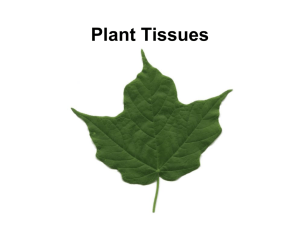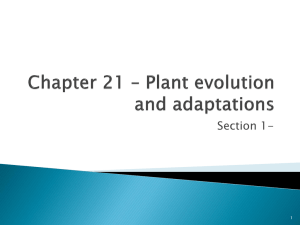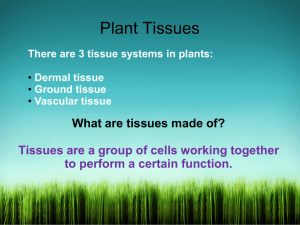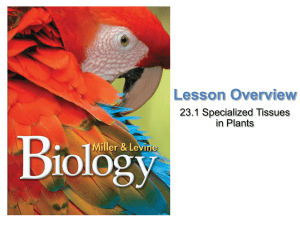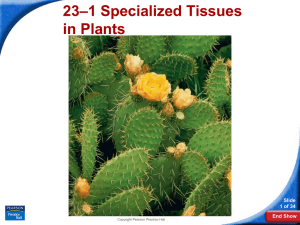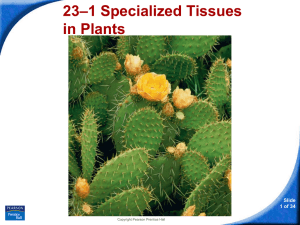Plant Tissues: Dermal, Vascular, Ground - Presentation
advertisement
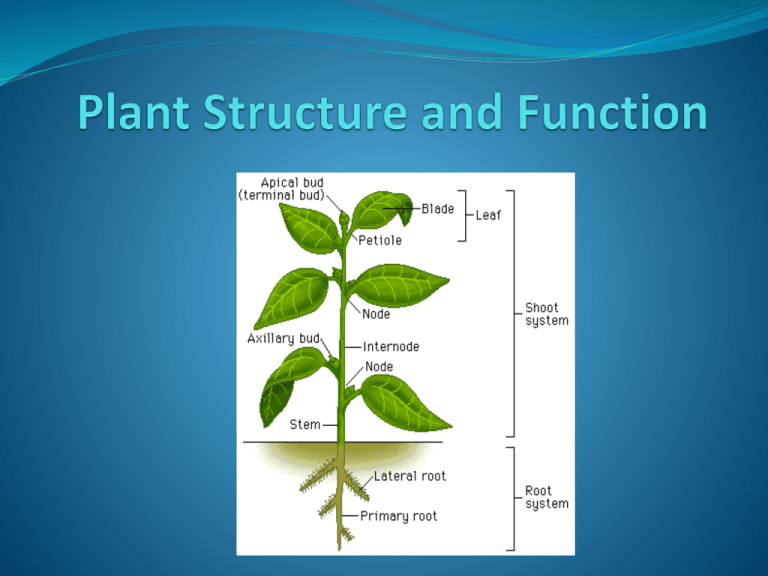
Specialized Tissues in Plants Plant Organs: Roots, Stems, and Leaves Roots Anchor the plant and absorb nutrients and water Mutualistic relationship with mycorrhizae and rhizobacteria Transport Nutrients to the plant Store Food Specialized Tissues in Plants Stems Support the plant Transport water and nutrients Protect against predators and disease Specialized Tissues in Plants Leaves Conduct photosynthesis Increased SA:V with leaf size Protect against water loss Waxy cuticle Stomata and Guard Cells Specialized Tissues in Plants Plant Tissues: Dermal, Vascular, and Ground Tissue Specialized Tissues in Plants Dermal Tissue Covers the plant Epidermis (epi = upon) – single layer of cells on the outside of the plant Cuticle – layer of wax that covers the epidermis and prevents water loss (polarity?) Trichomes – tiny hairlike projections for protection Bark – covers the epidermis in woody plants Root hair cells are found on the epidermis of roots to help absorb water (SA:V) Specialized Tissues in Plants Vascular Tissue Vessels that transport water and nutrients Plant “bloodstream” Xylem – carries water Phloem – carries nutrients Vascular Tissue - Xylem Tracheids – hollow plant cells of the xylem with thick cell walls strengthened by lignin Lignin resists water and is a major constituent in wood Openings in the cell walls of tracheids allow water to pass from cell to cell and therefore be transported throughout the plant Vessel Elements - hollow plants cells of xylem stacked end to end. Water passes from cell to cell through slit-like openings on the ends of each cell Vascular Tissue – Phloem Sieve Tube Elements – cells of the phloem that are arranged end to end and allow nutrients to flow throughout the plant in a watery stream Companion Cells – cells of the phloem that the sieve tube cells and aid in the movement of nutrients Specialized Tissues in Plants Ground Tissue Produces and Stores food (sugars) Composes most of the edible portions of plants Contributes to the physical support of the plant Ground tissue is composed of three main types of cells Parenchyma Collenchyma Sclerenchyma Ground Tissue Parenchyma Makes up the highest percentage of ground tissue Thin cell walls Large central vacuole Limited cytoplasm Contain many chloroplasts in leaves and are the main sight of photosynthesis Ground Tissue Collenchyma Chains of strong, flexible cell walls Provide support for plant organs Sclerenchyma Extremely thick and rigid cells walls Found on seed coats (strong!) Have been used to make rope from hemp Plant Growth and Meristems Meristems – regions of specialized plant cells in which mitosis produces new cells ready for differentiation The undifferentiated cells produced are much like the stem cells of animals Located in parts of plants that undergo rapid growth Allow even the oldest trees to produce new leaves and new reproductive organs each year Apical Meristem – located at the end (apex) of a root or stem. Leads to increase in root or stem length Once produced, the new cells differentiate into new dermal, vascular, and ground tissue Floral Meristems Produce the tissues of flowers Includes the plant’s reproductive organs as well as the colorful petals that surround them
